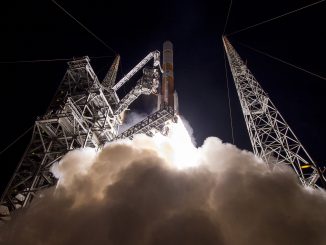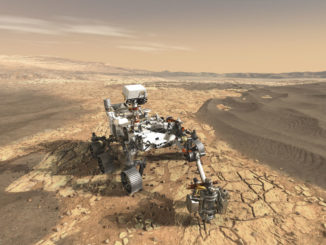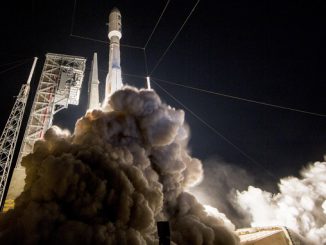
Work on Boeing’s CST-100 commercial crew capsule will ramp up at the program’s new home base in Florida this year, with construction of a crew access tower at the Atlas 5 rocket’s launch pad underway and assembly of a spacecraft test article due to begin in a converted space shuttle hangar.
“We started construction on the crew access tower on the Atlas 5 launch pad,” said John Elbon said, vice president and general manager for Boeing’s space exploration division. “That will be assembled in between the launches that happen on Atlas 5.”
A formal groundbreaking ceremony is planned for February, but construction workers have already taken core samples to prepare for pouring of the tower’s foundation, Boeing officials said Monday.
It will take about 18 months to complete construction of the tower, which will be installed a few feet to the west of the Atlas 5’s launch pad at Cape Canaveral.
When the structure is finished, astronauts will use it to board the CST-100 capsule mounted atop United Launch Alliance’s Atlas 5 rocket. The commercial spaceship will launch on a version of the workhorse booster with two solid rocket boosters and two RL10 upper stage engines.
The CST-100’s first two space missions — an unpiloted test flight and a demo mission with a two-person crew — are set for April and July 2017.
“The 52nd Atlas 5 mission flew a week or so ago,” Elbon said Monday. “Our orbital flight test, which is the uncrewed flight to the station, will be the 74th Atlas 5 mission, and the crewed flight test will be the 80th Atlas 5 mission. We’ve got those flights on the manifest, which is exciting.”
Boeing won a contract worth up to $4.2 billion to complete development of the CST-100 spacecraft and fly at least six operational missions to rotate astronaut crews on the International Space Station. The capsule will remain attached to the complex for up to 210 days, serving as a lifeboat back to Earth in case of an emergency.
SpaceX is working on a separate spacecraft dubbed the Crew Dragon, which will blast off on a Falcon 9 rocket from Kennedy Space Center’s Apollo- and shuttle-era launch pad 39A — now undergoing its own modifications.
One of the most visible changes in store at Cape Canaveral will be the build-up of a new structure at the Atlas 5’s launch facility.
The launch complex was originally designed as a “clean pad” without permanent service towers. The Atlas 5 rocket is stacked in the Vertical Integration Facility about 1,800 feet south of the launch pad. The rocket rolls to the launch pad on the eve of liftoff on top of a mobile launch table, which locks into place over the flame trench to connect the rocket with propellant plumbing and electrical power.
Engineers will assemble a crew access tower standing more than 20 stories tall, topped with a retractable arm with a white room through which astronauts will enter the CST-100 spacecraft. Engineers also designed a crew escape system designed to whisk astronauts safely away from the rocket in case of a dangerous countdown mishap.
The tower, which will sit on a 20-foot by 20-foot ground footprint, will be about a car width away from the mounting point for the Atlas 5 rocket’s mobile umbilical tower and launch platform.
ULA officials told reporters in a briefing last year the construction project would take about 18 months to complete. One of the first steps in construction will be to excavate about 30 feet of concrete, then drive 30-inch diameter pillars 105 feet into Florida bedrock.
Workers will prepare seven segments comprising the main structure of the crew access tower at a nearby staging point before transporting the steel sections to the launch pad between Atlas 5 launches for hoisting by a crane.
Once construction teams add the crew access arm and steel cladding, ULA plans to hook up hydraulics and instrumentation while testing the system with a CST-100 mockup at the launch pad.
The Atlas 5’s busy manifest, filled with missions for the U.S. military, NASA and commercial customers, will continue unabated during the launch pad rework.
Up to 14 Atlas 5 launches are planned from the launch pad during the 18-month construction phase.
Orlando, Florida-based Hensel Phelps Construction Co. is leading the contractor team working on the Atlas 5 launch pad modifications.
ULA is also working on an emergency detection system to be bolted to Atlas 5 rockets on crewed missions. The avionics box will monitor the health of the launch vehicle and trigger an in-flight abort if it detects a major anomaly.

While construction crews work on the Atlas 5 launch pad, Boeing expects the first CST-100 capsule components to arrive at the spacecraft’s manufacturing facility at Kennedy Space Center in February, Elbon said.
The components will be integrated into the CST-100’s structural test article, a ground version of the capsule designed for testing.
“We build that up and we load it to make sure that the design matches the load paths,” Elbon said. “This fall, the pieces that will make up the qualification test vehicle, which then gets refurbished to become the crew flight test vehicle, will be arriving.”
Boeing’s CST-100 factory is inside the space shuttle program’s Orbiter Processing Facility No. 3, which NASA used to work on shuttles between flights. Boeing has renamed the building — to the northwest of the huge Vehicle Assembly Building — the Commercial Crew and Cargo Processing Facility, or C3PF.
Most of Boeing’s CST-100 team will relocate to Florida this year. The capsule’s critical design review is scheduled for March, Elbon said, completing the program’s design phase and clearing the spacecraft to begin manufacturing.
Some of the program’s offices responsible for crew training and mission operations will remain in Houston. The same mission control and crew training team — composed of NASA civil servant and contractors — that oversees daily activities on the space station and prepares astronauts for spaceflight have been subcontracted to work on Boeing’s commercial space capsule.
“Our design activity has happened here in Houston,” Elbon told reporters at JSC. “We’ve got 400 to 500 people working here today. We’ve teamed with the NASA flight operations directorate to do our mission planning, training and flying, mainly to leverage that expertise. That organization is world-class, and they’ve been doing that for a long time. That will be done here.
“The crew will be trained in Houston, the mission planning will be done in Houston, and mission control will be out of the Mission Control Center,” Elbon said. “Having said that, all the manufacturing, the program office and the engineering will eventually migrate to Florida. We’re building up the team in Florida as we finish the design in Houston.”
Follow Stephen Clark on Twitter: @StephenClark1.



